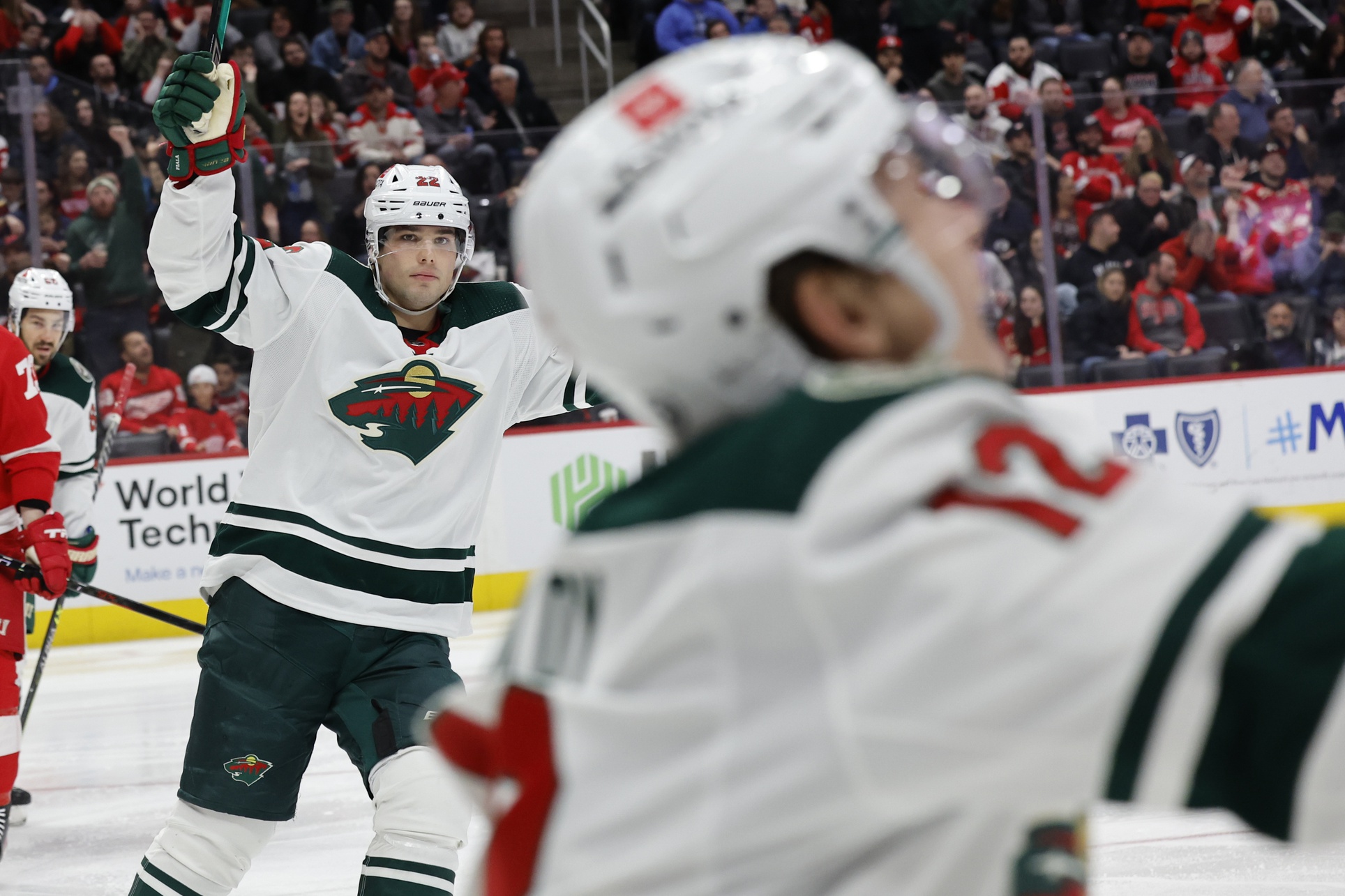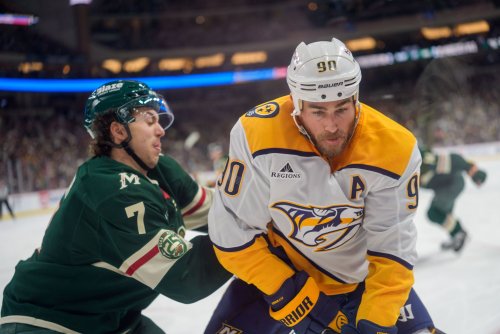
Think of all the big names the Minnesota Wild tried to bring in over the years.
Martin Havlat coming off a 77-point season. Former 50-goal scorer Dany Heatley. 30-goal scoring youngster Devin Setoguchi. $98 million dollar men in Zach Parise and Ryan Suter. Another 30-goal scorer in Jason Pominville. Yet another whack at the Buffalo Sabres pinata in goal-scoring wizard Thomas Vanek. A Cup-winning captain in Eric Staal.
Throw in much-hyped hot-shot prospects like Mikael Granlund, Jason Zucker, Charlie Coyle, and Nino Niederreiter. While we're at it, more trade acquisitions in Matt Moulson, Chris Stewart, and Martin Hanzal. We're at, what? Over a dozen names? Aside from donning the green-and-wheat, what did they all have in common?
All of them were rolls of the dice that Minnesota would get that one star player they were missing to break through to a Stanley Cup.
One more thing: All of them left the organization falling short of that goal.
It's now 2022, and look at this, the Wild have their first player who really, truly fits the bill. Kirill Kaprizov easily sailed to a Calder Trophy win last year, but this year has been a new level. He's sixth in the NHL in scoring, has the first 100-point season in team history, and we could literally list 100 more facts about how great he is. He's indisputably a superstar.
So Minnesota has that missing piece. Now they only have to ask: What about the rest?
Most everyone agrees Minnesota has a skilled team that's deep and plays a heavy game. That's all great, but as Hockey Prospecting's Byron Bader points out, to win the Cup, you gotta have stars. And not just one star, either.
Since the 2004-05 lockout season (or, the salary cap era), Cup winning-teams have an average of 4.5 stars on their roster. There are only three exceptions that have fewer than four. The 2007-08 Anaheim Ducks, who had three Hall of Famers in Teemu Selanne, Scott Niedermayer, and Chris Pronger, along with a not-yet-blossomed Ryan Getzlaf and Corey Perry. In 2011-12, the Boston Bruins won anchored by Hall of Famers Patrice Bergeron, Zdeno Chara, and incredible goaltending. And then there's the 2018-19 St. Louis Blues, who... well, you got me there.
As for everyone else, they either have a lot of star power, multiple Hall of Fame guys, or both.
So, where do the Wild stand?
At best, Minnesota is in the middle of the pack in the West. Among playoff teams, only the Los Angeles Kings, Nashville Predators, and Calgary Flames boast fewer star players than Minnesota. They're tied with the Edmonton Oilers for fifth in the West, but Edmonton probably has an edge in a Hall of Fame tiebreak with Connor McDavid and Leon Draisaitl.
As for their first two likely opponents — St. Louis and the Colorado Avalanche — there's a pretty big deficit. St. Louis and Colorado both have five stars to the Wild's four, and then out-number them in star-caliber seasons by two and three, respectively. Sounds like a tough spot to be in.
But hey, star power is subjective. So what is a star, anyway? Using Hockey Prospecting's definition, that's any forward who averages 0.7 or more points through their career or any defenseman who averages 0.45 or more points. It's perhaps crude, but as you can see, the more players you have earning lots of points, the better you're probably doing.
So who are the Wild's stars? That might surprise you! Kaprizov (1.16 points per game) obviously highlights the bunch, but the rest are Mats Zuccarello (0.74 PPG), and a pair of defensemen in Jared Spurgeon (0.45 PPG) and Alex Goligoski (0.46 PPG).
That's one bonafide, no-doubt star in Kaprizov, a player with a defensive value which adds to his production in Spurgeon, and a couple of older, borderline stars in Zuccarello (who just hit the star threshold this year) and Goligoski. Is that going to be enough?
To get a fuller picture of stardom, Bader adds "Star Seasons" to the mix here, which includes single seasons at those thresholds. They lose Goligoski from this second list (0.42 PPG this year), but the Wild look better here. Kevin Fiala headlines (1.05 PPG this year), with Matt Boldy (0.87 PPG) Ryan Hartman (0.79 PPG), and Matt Dumba (0.46 PPG) joining the mix. Those seven still lag behind Colorado and St. Louis but also are tied for third with Edmonton and Calgary among West playoff teams.
Among the Wild's Star Seasons, Fiala's the most intriguing case to be considered a True Star. His career sits at 0.68 PPG, only barely missing the cutoff. Remove his time as a rookie (first 60 career games), and that jumps to 0.74, comfortably above the star threshold. Now include just his stats since arriving in Minnesota at age-22. You get 0.87 PPG, more than anyone in Wild history except Kaprizov and (by less than 0.002 PPG) Marian Gaborik.
His career rate for the Wild compares pretty well with Cup-winning stars in Brayden Point, Ryan Getzlaf, Anze Kopitar, and Vladimir Tarasenko. Pretty good company!
Boldy's not far behind Fiala in that category. With 39 points through 45 games as an age-20 player, he's already well on his way to ascending to that club. If he can roll his production into the playoffs, he'll give Minnesota another very high-end player entering the playoffs.
Even so, the Wild might have to find star power that slips through the cracks of Bader's system to compete with the Blues and Avs, and maybe even get an edge over Edmonton and Calgary. Can they do that?
They've got two players living on the borderline with defensive value that can just maybe push them over the line.
The first is Joel Eriksson Ek, who has 0.65 points per game this season, just barely missing the cutoff for a Star Season. Eriksson Ek basically repeated his breakout year from last season, only with 75 games and a bunch more assists this go-around. Pair his production with being the eight-stingiest defensive forward in the league (allowing 1.88 expected goals per hour at 5-on-5, per Evolving Hockey), and that might be enough to nudge him into a star-caliber season.
Then there's another interesting case in Jonas Brodin. His first seven seasons in the league were nowhere near star-caliber, averaging 0.24 PPG. However, he was (and remains) one of the league's top shutdown defenders. While that is certainly enough to make him a very good top-4 defenseman, that production wasn't borderline enough to push him into star territory.
But what about now? He was borderline over the last three years, with 0.42 PPG. This year, he's at 0.41, and his defense remains stellar. Evolving Hockey rates his even-strength defense as the fifth-best in the NHL this year and the very best in the league over the last three. Should that count for something?
If it does, and if you squint, you can maybe get Minnesota to match their rivals in star power.
Go by the Eye Test, and you can maybe count Fiala and Boldy as True Stars. Both are good bets to be soon enough, anyway. Maybe you drop Goligoski, who doesn't quite pass it and isn't having a star-caliber season. Nudge Eriksson Ek and Brodin over the line for a Star Season. That's five and nine, which matches Colorado, and is just barely behind St. Louis.
Whether their stars-to-star seasons ratio is 4:7, 5:9, or somewhere in-between, do they have enough star power to win? Honestly, it's so hard to tell. This is a team that is, contrary to their marketing, both weird and Wild. Kaprizov's superstar status anchors the team, but past him, many of their best players are hard to sort into star or non-star boxes.
As such, Minnesota is probably the biggest "Who knows?" team entering the playoffs. Just like opinions on their star power will vary, so will predictions surrounding them. No one would be shocked to see the Wild bounce out of the first round. And aside from perhaps Colorado, no one should be surprised if they beat anyone in the West.
Where do the Wild stack up? You don't know, Zone Coverage doesn't know, and neither does anyone else. The good news is that we'll finally start finding out next week.
Think you could write a story like this? Hockey Wilderness wants you to develop your voice, find an audience, and we'll pay you to do it. Just fill out this form.








Recommended Comments
There are no comments to display.
Join the conversation
You can post now and register later. If you have an account, sign in now to post with your account.
Note: Your post will require moderator approval before it will be visible.